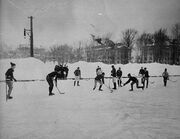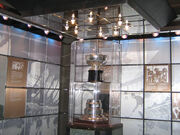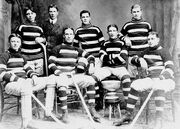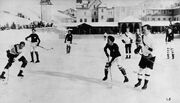Ice hockey is considered to have evolved from stick-and-ball games, played outdoors, and adapted to the icy conditions of Canada in the 1800s. The games of British soldiers and immigrants to Canada, influenced by stick-and-ball games of First Nations, evolved to become a game played on ice skates, often played with a puck, and played with sticks made by the Mi'kmaq of Nova Scotia. The name of hockey itself has no clear origin, though the first known mention of the word 'hockey' in English dates to 1799 in England.

Mi'kmaq making hockey sticks in Nova Scotia circa 1890
Stick and ball games have a long history dating to pre-Christian times. In Europe, these games included the Irish sport of hurling, the closely related Scottish sport of shinty, and versions of field hockey, including "Bandie ball," played in England. European immigrants to Canada brought their games with them and adapted them for icy conditions. Often these games were recreation for British soldiers on postings. In Canada, from oral histories, there is evidence of a tradition of an ancient stick and ball game played among the Mi'kmaq First Nation in Eastern Canada. In Legends of the Micmacs (1894), Silas Rand describes a Mi'kmaq ball game people called tooadijik. Rand also describes a game which was played (likely after European contact) with hurleys, called wolchamaadijik.[1]

Ye Gude Olde Days, from Hockey: Canada's Royal Winter Game, 1899.
Early 1800s paintings show "shinney," an early form of ice hockey with no standard rules, being played in Nova Scotia, Canada. These early games may have also absorbed the physically aggressive aspects of what the Mi'kmaq in Nova Scotia called dehuntshigwa'es (lacrosse). Games of shinney are also known to have been played on the St. Lawrence River at Montreal and Quebec City and in Kingston[2] and Ottawa in Ontario. The number of players on these games was often large. To this day, shinny (or shinney) (derived from Shinty) is a popular Canadian term for an informal type of hockey, either on ice or as street hockey.
In 1825, Sir John Franklin wrote that "The game of hockey played on the ice was the morning sport" while on Great Bear Lake during one of his Arctic expeditions. In 1843 a British Army officer in Kingston, Ontario, wrote "Began to skate this year, improved quickly and had great fun at hockey on the ice."[2] An article in the Boston Evening Gazette, in 1859, makes reference to an early game of hockey on ice occurring in Halifax in that year.[3]
Thomas Chandler Haliburton, in The Attache: Second Series, published in 1844, reminisced about boys from King's College School in Windsor, Nova Scotia, playing "hurly on the long pond on the ice" when he was a student there, no later than 1810.[1][3] Based on Haliburton's writings, there have been claims that modern ice hockey originated in Windsor, Nova Scotia, by King's College students and was named after an individual, as in “Colonel Hockey's game.”[4] Others claim that the origins of ice hockey come from games played in the area of Dartmouth and Halifax in Nova Scotia.
Naming[]
In 1799, William Pierre Le Cocq, in a letter written in Cheshire, Buckinghamshire, England, provides the earliest known reference to the word 'hockey': “I must now describe to you the game of Hockey; we have each a stick turning up at the end. We get a bung. There are two sides one of them knocks one way and the other side the other way. If any one of the sides makes the bung reach that end of the churchyard it is victorious.”[5]
According to the Austin Hockey Association, the word puck is derived from the Scottish Gaelic word "puc" or the Irish word "poc," meaning to poke, punch or deliver a blow. This definition is explained in a book published in 1910 entitled "English as we Speak it in Ireland" by P. W. Joyce. It defines the word puck as "... The blow given by a hurler to the ball with his caman or hurley is always called a puck."
Foundation of modern ice hockey[]

Ice hockey at McGill University, Montreal, 1901.

The original Stanley Cup, in the Hockey Hall of Fame vault.

Ottawa Hockey Club "Silver Seven" (the original Ottawa Senators), the Champion of the Stanley Cup in 1905

Ice hockey in Europe; Oxford University vs. Switzerland, 1922. Future Canadian Prime Minister Lester Pearson is at right front.
While the game's origins may lie elsewhere, Montreal is at the centre of the development of the modern sport of ice hockey. On March 3, 1875 the first organized indoor game was played at Montreal's Victoria Skating Rink between two sides of nine-player teams including James Creighton and several McGill University students. Instead of a ball, the game featured the use of a puck, the purpose of which was to prevent the puck from exiting the rink, which did not have boards, and hitting spectators. The goals were goal posts 6 ft apart, and the game lasted 60 minutes.
In 1877, several McGill students, including Creighton, Henry Joseph, Richard F. Smith, W. F. Robertson, and W. L. Murray codified seven ice hockey rules, based on the rules of field hockey. The first ice hockey club, McGill University Hockey Club, was founded in 1877[6] followed by the Montreal Victorias, organized in 1881.[7]
The game became so popular that the first "world championship" of ice hockey was featured in Montreal's annual Winter Carnival in 1883 and the McGill team captured the "Carnival Cup".[8] The number of players per side was reduced to seven, and the games now organized into thirty-minute halves. The positions were now named with left and right wing, centre, rover, point and cover point, and goalkeeper. In 1885, the Montreal City Hockey League was established. In 1886, the teams which competed at the Winter Carnival would organize the Amateur Hockey Association of Canada (AHAC) league and play a regular season composed of "challenges" to the existing champion.[9]
In Europe, it is believed that in 1885 the Oxford University Ice Hockey Club was formed to play the first Ice Hockey Varsity Match against traditional rival Cambridge in St. Moritz, Switzerland, although this is undocumented. This match was won by the Oxford Dark Blues, 6-0. The first photographs and team lists date from 1895.[10] This rivalry continues, claimed to be the oldest hockey rivalry in history. It was not the only game on ice derived from stick-and-ball games played in Europe. In this time period, the game of Bandie ball was adapted to the ice, evolving into Bandy, which endured in popularity in Europe into the 1900s, and remains popular today in Russia.
In 1888, the new Governor General of Canada, Lord Stanley of Preston, whose sons and daughter became hockey enthusiasts, attended the Montreal Winter Carnival tournament and was impressed with the hockey spectacle. In 1892, recognizing that there was no recognition for the best team in all of Canada (various leagues had championship trophies), he purchased a decorative bowl for use as a trophy. The Dominion Hockey Challenge Cup, which later became more famously known as the Stanley Cup, was first awarded in 1893 to the Montreal HC, champions of the AHAC. It continues to be awarded today to the National Hockey League's championship team.[11] Stanley's son Arthur helped organize the Ontario Hockey Association and Stanley's daughter Isobel was one of the first women to play ice hockey.
By 1893, there were almost a hundred teams in Montreal alone, and leagues throughout Canada. Winnipeg hockey players had incorporated cricket pads to better protect the goaltender's legs. They also introduced the "scoop" shot, later known as the wrist shot. Goal nets became a standard feature of the Canadian Amateur Hockey League(CAHL) in 1900. Left and right defence began to replace the point and cover point positions in 1906 in the OHA.[12]
A similar sport had been popular in the United States (US) during this time called ice polo, but by 1893 the first ice hockey matches were being played at Yale University and Johns Hopkins University.[13] Ice polo, played in the New England area, would die out as Americans adopted ice hockey. In 1896, the first ice hockey league in the US was formed. The U. S. Amateur Hockey League was founded in New York City shortly after the opening of the St. Nicholas Rink and its artificial ice rink.
Lord Stanley's five sons were instrumental in bringing ice hockey to Europe, beating a court team (which included both the future Edward VII and George V) at Buckingham Palace in 1895. By 1903 a five-team league had been founded. The Ligue Internationale de Hockey sur Glace was founded in 1908 to govern international competitions, and the first European championships were won by Great Britain in 1910. In the mid-20th century, the League became the International Ice Hockey Federation.[14]
Professional era[]
Professional ice hockey has existed from the early 1900s. By 1902, the Western Pennsylvania Hockey League was the first to openly employ professionals. The league joined with teams in Michigan and Ontario to form the first fully professional International Professional Hockey League (IPHL), in 1904. The IPHL hired numerous players from Canada and Canadian leagues in response started to openly pay players, who played alongside amateurs. The IPHL, cut off from its biggest source of players, disbanded in 1907. By then, several professional hockey leagues were operating in Canada, with leagues in the Manitoba, Ontario and Quebec provinces of Canada.
In 1910, the National Hockey Association (NHA) was formed in Montreal. The NHA would further refine the rules, dropping the rover position, splitting the game into three 20-minute periods and introducing the system of minor and major penalties. After re-organizing as the National Hockey League (NHL) in 1917, the league expanded into the United States in 1924.
Professional ice hockey leagues developed later in Europe. The game of bandy was still popular and amateur leagues leading to national championships were in place. One of the first was the Swiss National League A, founded in 1916. Today, professional leagues have been introduced in most countries of Europe. The top leagues in Europe include the Kontinental Hockey League, the Czech Extraliga, the Finnish SM-liiga and the Swedish Elitserien.
| This page uses content from Wikipedia. The original article was at History of ice hockey. The list of authors can be seen in the page history. As with Ice Hockey Wiki, the text of Wikipedia is available under the Creative Commons Attribution-Share Alike License 3.0 (Unported) (CC-BY-SA). |
References[]
- Farrell, Arthur (1899). Hockey: Canada's Royal Winter Game.
- Selke, Frank (1962). Behind The Cheering. Toronto, Ontario: McClelland and Stewart Ltd.
- Vaughan, Garth (1996). The Puck Stops Here: The origin of Canada's great winter game. Goose Lane Editions.
- Notes
- ↑ 1.0 1.1 Dalhousie University (2000). Thomas Raddall Selected Correspondence: An Electronic Edition. Print source: Thomas Raddall Fonds, Correspondence. From Thomas Raddall to Douglas M. Fisher, 25 January 1954. MS-2-202 41.14. Retrieved on 2009-05-10.
- ↑ 2.0 2.1 Hockey night in Kingston. Retrieved on June 21, 2006.
- ↑ 3.0 3.1 Vaughan, G. (1999). "Quotes Prove Ice Hockey's Origin. " Birthplace of Hockey. Retrieved on: 2009-05-10.
- ↑ Vaughan, Garth (1996). The Puck Stops Here: The origin of Canada's great winter game. Fredericton: Goose Lane Editions, 23.
- ↑ Giden, Carl (2010). Stick and Ball Game Timeline. Society for International Hockey Research.
- ↑ Zukerman, Earl (March 17, 2005). McGill’s contribution to the origins of ice hockey. Archived from the original on October 4, 2006. Retrieved on October 11, 2006.
- ↑ Farrell, Arthur (1899). Hockey: Canada's Royal Winter Game, 27.
- ↑ The trophy for this tournament is on display at the Musee McCord Museum in Montreal. A picture of this trophy can be seen at ?..
- ↑ "Sports and Pastimes, hockey, Formation of a Dominion Hockey Association", The Gazette, December 9, 1886.
- ↑ Oxford University Ice Hockey Club. History. Retrieved on October 11, 2006.
- ↑ Podnieks, Andrew; Hockey Hall of Fame (2004). Lord Stanley's Cup. Triumph Books. ISBN 1-55168-261-3.
- ↑ Selke, p. 21
- ↑ "Hockey (Ice)", The Canadian Encyclopedia, Historical Foundation of Canada, 2006, <http://www.thecanadianencyclopedia.com/index.cfm?PgNm=TCE&Params=A1ARTA0003794>
- ↑ International Ice Hockey Federation. History of Ice Hockey. Archived from the original on July 19, 2006. Retrieved on October 11, 2006.
